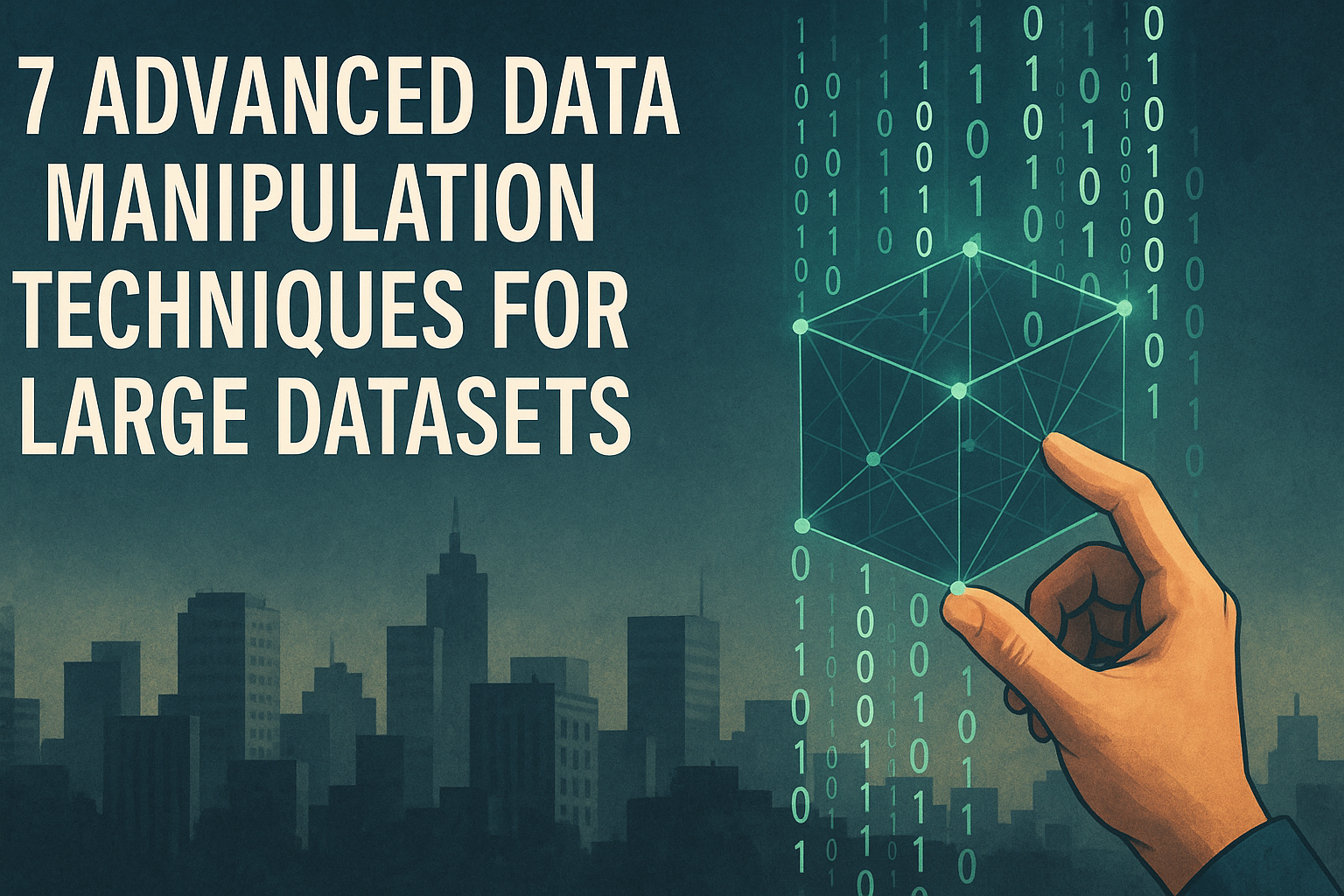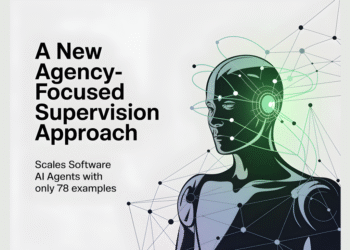
Beyond Pandas: 7 Advanced Data Manipulation Techniques for Large Datasets
Image by Editor | ChatGPT
Introduction
If you’ve worked with data in Python, chances are you’ve used Pandas many times. And for good reason; it’s intuitive, flexible, and great for day-to-day analysis. But as your datasets start to grow, Pandas starts to show its limits. Maybe it’s memory issues, sluggish performance, or the fact that your machine sounds like it’s about to lift off when you try to group by a few million rows.
That’s the point where a lot of data analysts and scientists start asking the same question: what else is out there?
This article is about answering that question. We’re going to look at seven tools and techniques that go beyond Pandas, things built for bigger data, faster execution, and more efficient pipelines. By the end of this, you’ll know when to switch gears, what tool to reach for, and how to actually use it in your own workflows.
1. Use Dask for Parallelized DataFrames
Pandas is great until the dataset you’re working with doesn’t fit in memory. Once you hit that wall, things get messy fast. That’s where Dask comes in.
Dask is built to feel familiar to Pandas users, but behind the scenes, it splits your data into chunks and processes them in parallel. It doesn’t try to load everything at once. Instead, it works with pieces of the data on demand and can even spread the computation across multiple cores or machines. You get a huge performance gain without rewriting your entire workflow.
The real magic of Dask comes from three things:
- Lazy evaluation: Dask doesn’t run operations immediately. It builds a task graph and executes only when needed, which means fewer wasted computations.
- Out-of-core computing: You can work with datasets that are larger than your RAM by streaming them from disk.
- Parallel execution: Operations like filtering, joins, and groupbys can run across multiple CPU cores without any extra effort from you.
Here’s a simple example that shows how to load a large CSV and run a groupby operation, just like you would in Pandas:
|
import dask.dataframe as dd
# Load data (lazy by default) df = dd.read_csv(“large_file.csv”)
# Group by and compute mean result = df.groupby(“category”)[“sales”].mean().compute()
print(result) |
Notice the .compute() at the end; that’s where Dask actually triggers the computation. Until then, it’s just building the recipe for what needs to happen.
2. Accelerate with Polars
If Dask helps you go wider with parallelism, Polars helps you go faster. It’s not just fast for the sake of being fast; it’s fast in a way that feels like cheating.
Polars is a DataFrame library written in Rust, and it leans on the Apache Arrow memory format to get ridiculous speedups. That means when you run a query, it compiles a plan, runs it across multiple threads, and delivers results before Pandas would even finish parsing your CSV.
But here’s what makes it stand out: Polars isn’t just about speed. It’s also about pipeline thinking. You don’t write a line-by-line script; you build a chain of transformations that only get executed when needed.
Let’s look at an example using Polars’ lazy API. We’ll read a large file, filter it, and run a groupby aggregation all without loading everything into memory at once:
|
import polars as pl
# Lazy load and transform result = ( pl.read_csv(“large_file.csv”).lazy() .filter(pl.col(“sales”) > 1000) .groupby(“region”) .agg(pl.col(“sales”).mean().alias(“avg_sales”)) .sort(“avg_sales”, descending=True) .collect() # triggers execution )
print(result) |
Notice that collect() at the end? That’s the moment it all runs. Up until then, you’re just building a plan. And because Polars compiles that plan, it runs tight and clean, with no Python bottlenecks, no row-by-row iteration.
Polars really shines when you need maximum speed on a single machine. Think dashboards, analytics pipelines, or cleaning large exports before feeding them into a model. If you’re hitting performance walls with Pandas and don’t want to spin up clusters or mess with parallel engines, this is your shortcut.
Also worth noting: the syntax is clean. Once you get used to thinking in expressions, it feels sharper than writing loops and chained Pandas calls.
3. Work with Apache Arrow
Sometimes speed isn’t about crunching numbers faster. Sometimes it’s about not moving data around when you don’t have to. That’s exactly where Apache Arrow comes in.
Arrow isn’t a tool you’ll usually interact with directly, like Pandas or Polars; it’s more like the plumbing underneath. But once you understand what it does, you start to see how it fits into many modern workflows.
At its core, Arrow is a columnar in-memory format. That means it stores data in columns (not rows) and in a layout that’s designed for speed, not just inside one tool, but between tools. So when Pandas, Polars, PySpark, or even database engines speak Arrow, they can pass data between each other without copying or converting it. No serialization and no waiting.
Let’s make this practical. Say you’ve got a Pandas DataFrame and want to move it into Polars for a faster groupby or export it so that another service can use it without reprocessing.
Here’s how that might look:
|
1 2 3 4 5 6 7 8 9 10 11 12 13 14 15 16 17 |
import pandas as pd import pyarrow as pa import polars as pl
# Create sample Pandas DataFrame df_pandas = pd.DataFrame({ “region”: [“West”, “East”, “South”, “West”], “sales”: [100, 200, 150, 300] })
# Convert to Arrow Table arrow_table = pa.Table.from_pandas(df_pandas)
# Load into Polars directly from Arrow df_polars = pl.from_arrow(arrow_table)
print(df_polars) |
That little from_arrow() step skips all the overhead you’d normally get when converting formats. It’s instant, zero-copy, and memory-efficient.
Use Arrow when you care about performance at the boundaries: moving between tools, reading/writing files, or connecting with cloud services. You won’t use it to analyze data directly, but when it’s working in the background, your whole pipeline runs smoother.
4. Query with SQL Engines (e.g. DuckDB, SQLite)
Sometimes, the fastest way to work with large data isn’t Pandas, Polars, or Spark; it’s good old SQL. That’s not just nostalgia talking. SQL is still one of the most efficient ways to run analytical queries, especially when all you need is to filter, group, or join large datasets without spinning up an entire processing pipeline.
DuckDB is like SQLite, but optimized for analytical workloads. It can query Parquet files, CSVs, or Arrow tables directly, without loading them into memory as DataFrames. And it runs entirely on your machine, no server, no cluster, no setup. Just install the package and write SQL.
Here’s an example. Let’s say you’ve got a big Parquet file and want to find average sales per category, filtered by date:
|
import duckdb
# Query a Parquet file directly query = “”“ SELECT category, AVG(sales) AS avg_sales FROM ‘data/transactions.parquet’ WHERE transaction_date >= ‘2023-01-01’ GROUP BY category ORDER BY avg_sales DESC ““”
result = duckdb.query(query).to_df()
print(result) |
No need to load the file with Pandas first; DuckDB takes care of parsing, filtering, grouping, and it does it fast. It’s also smart about pushing filters down to the file level (especially with Parquet), so it doesn’t waste time scanning what it doesn’t need.
And if you’re working on a team where SQL is the common language, this is a great way to prototype locally before scaling out to a full database.
Use DuckDB when:
- Your data is too big for Pandas, but you’re not ready for Spark
- You want to query data directly from disk (CSV, Parquet, Arrow)
- You need quick, repeatable, SQL-based analysis without setting up infrastructure
5. Use PySpark for Distributed Processing
At some point, your dataset gets so big that it doesn’t just slow your machine down; it breaks it. That’s when it’s time to bring out PySpark.
PySpark gives you the power of Apache Spark with a Python interface. It’s built for distributed computing, meaning it can process data across multiple cores or machines without you having to manage the low-level plumbing. If you’re working with data lakes, billions of rows, or production-grade pipelines, this is the tool you want in your corner.
Spark gives you two main ways to work: RDDs (Resilient Distributed Datasets) and DataFrames. Unless you have a very specific reason to go low-level, stick with DataFrames. They’re optimized, easier to write, and much more familiar if you’ve used Pandas or SQL.
Let’s walk through a basic PySpark pipeline, reading a large CSV, filtering, and aggregating:
|
1 2 3 4 5 6 7 8 9 10 11 12 13 14 15 16 17 18 19 |
from pyspark.sql import SparkSession from pyspark.sql.functions import col, avg
# Start a Spark session spark = SparkSession.builder.appName(“SalesAnalysis”).getOrCreate()
# Read large CSV file df = spark.read.csv(“large_sales.csv”, header=True, inferSchema=True)
# Filter and group by result = ( df.filter(col(“region”) == “West”) .groupBy(“category”) .agg(avg(“sales”).alias(“avg_sales”)) .orderBy(“avg_sales”, ascending=False) )
# Show results result.show() |
This looks a lot like Pandas, but the execution is completely different. The operations are lazily evaluated and optimized under the hood before running across your entire cluster (or even locally, if you’re just testing).
Use PySpark when:
- Your data can’t fit on a single machine
- You’re working in a distributed environment (like a cloud platform or on-prem cluster)
- You need fault tolerance, retry logic, and scalability built into your workflow
One thing to note: PySpark isn’t always the fastest option for small tasks. It shines when scale and resilience matter more than convenience or startup time.
6. Optimize with Vaex
If you’ve ever tried to load a massive CSV into Pandas and watched your RAM vanish in seconds, you’re not alone. Most DataFrame tools try to hold everything in memory, and that just doesn’t scale when you’re dealing with 100 million rows or more.
Vaex is a DataFrame library built specifically for high-performance, single-machine analytics. It’s fast, memory-efficient, and built for laziness, not in a bad way, but in the don’t-load-it-until-you-actually-need-it kind of way.
What makes Vaex different is that it uses memory-mapped files. Instead of loading your entire dataset into RAM, it reads chunks directly from disk on demand. Combine that with its optimized backend (written in C++), and you get lightning-fast operations like filtering, aggregations, and joins even on huge datasets.
Here’s how that looks in practice:
|
import vaex
# Open a large CSV (or HDF5, Arrow, Parquet, etc.) df = vaex.open(“big_data.csv”) # this can be >100M rows
# Filter and groupby lazily result = ( df[df.sales > 1000] .groupby(“category”, agg=vaex.agg.mean(“sales”)) )
print(result) |
That’s it; no .compute() call needed. Vaex figures out the optimal execution path behind the scenes and runs it only when it has to. It also caches results and minimizes unnecessary recalculations.
When should you reach for Vaex?
- You’re working with big datasets (tens or hundreds of millions of rows) but don’t want the overhead of Dask or Spark
- You want blazing-fast, analytics-style queries: filters, bins, histograms, joins
- You need something efficient that can run on a single machine without eating all your RAM
7. Chunked and Streaming Processing with Generators
Sometimes, the smartest move is to go low-level. When your machine is choking on a file and every tool feels too heavy, Python’s built-in tools can still save the day. In situations where memory is extremely tight—maybe you’re working on an embedded device, running inside a lambda function, or just trying to avoid loading hundreds of megabytes into RAM—you don’t always need a DataFrame at all.
Generators and file iterators let you stream data one row at a time. You don’t load the file; you process it in motion. That means constant memory usage, no spikes, and full control over what happens next.
Here’s a simple example: reading a large CSV line by line, filtering rows, and doing some light transformation as you go:
|
1 2 3 4 5 6 7 8 9 10 11 12 13 14 15 16 17 |
def process_csv(path): with open(path, “r”) as f: header = next(f).strip().split(“,”) for line in f: row = line.strip().split(“,”) record = dict(zip(header, row))
# Example transformation if float(record[“sales”]) > 1000: yield { “region”: record[“region”], “sales”: float(record[“sales”]) * 1.1 # apply markup }
# Usage for item in process_csv(“large_file.csv”): print(item) |
No Pandas. No libraries. Just clean iteration with total control. When should you go this route?
- You’re operating in tight memory environments, like cloud functions or edge computing
- You need to stream data, row-by-row, possibly into another system (like a database, API, or file)
- You want to build your own lightweight ETL pipeline without the overhead of larger frameworks
Wrapping Up
The point of this overview isn’t to pick a winner. It’s to pick the right tool for the job.
If you want to scale out your Pandas code with minimal changes, Dask is a solid first step. For pure speed on a single machine, Polars is shockingly fast. If you care about interoperability or passing data between systems, Arrow keeps things tight and efficient. Prefer SQL? DuckDB lets you run analytical queries on big files without setting up a database.
Working with massive datasets or enterprise pipelines? That’s PySpark territory. Need fast analytics without leaving your laptop? Vaex gives you memory-mapped performance with a Pandas feel. And when you just need to keep it simple and tight, Python’s own generators can stream through data one line at a time without breaking a sweat.
Sometimes combining tools is the “best” approach: using Arrow with Polars, or loading files into DuckDB and exporting to Arrow for another step in the pipeline. You don’t have to stay in one ecosystem. And you don’t need to ditch Pandas completely, either.
What matters is knowing your options and building a stack that works with your data and not against it.
Try them out. Mix and match. See what clicks.


















